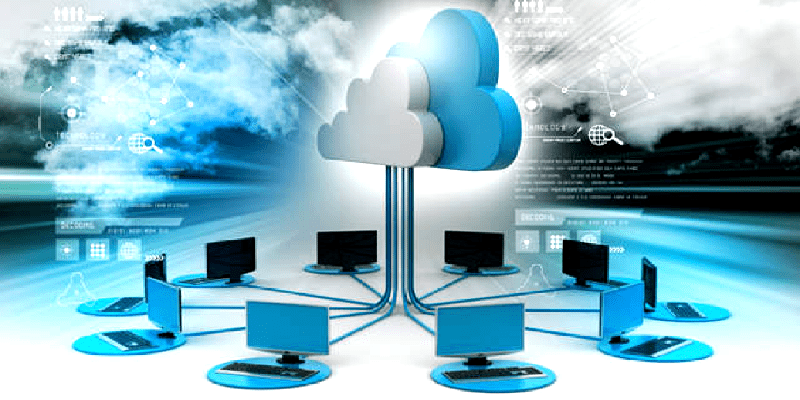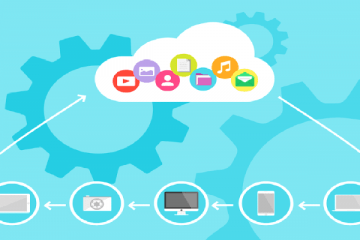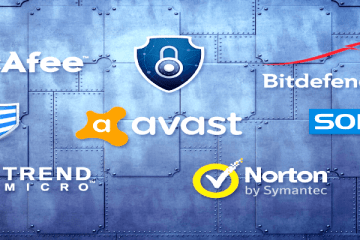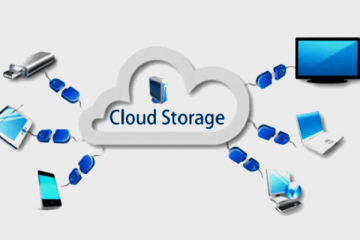What is Cloud Architecture?
Cloud architecture is the different elements that make up a cloud. The cloud, in this sense, refers to an external infrastructure hosted by a third-party vendor. You can quickly picture how the cloud looks like and how many monies you have access to. This philosophical focus of the cloud is consistent with other features of the cloud.
Related
The Best Cloud Storage Solutions for Small Business
Types of Cloud Architecture Designs
Public cloud
A cloud service is operated by the operator and accessed through a pay-per-service model via the internet. This implementation model leverages a cloud provider to support IT storage and operating services, but it’s the cloud provider that is responsible for the development and management of those tools. Public cloud services are suitable for small businesses with a tight budgetary concern who desire a fast deployment platform.
Private cloud
This cloud deployment model is operated by a single company that requires bespoke architecture. It provides a centralized IT environment in which the enterprise can have greater control of its IT finances. The model can be handled directly by an outside entity or in-house. Though private cloud hosting can be pricey, for larger companies it can provide a higher level of security and a greater degree of control.
Hybrid Cloud
For companies who want to distribute applications in both private and public cloud environments, a hybrid cloud management solution is best. By integrating the two Cloud architectures, a hybrid Cloud platform best meets the demands of the market.
Some Best Cloud Architecture Designs
Several cloud architectures usually include front-end & back-end computing platforms, cloud-based distribution, and cloud-based network infrastructure. A cloud architecture diagram identifies the parts of an application, as well as their relationships. The main components of the Cloud Architecture are:
- 1. On-premise and cloud infrastructure.
- 2. Component and utility software.
- 3. Middleware.
The key reason for using a Cloud Architecture Diagram is to show how the architecture of the Cloud is organized. The several different types of these Cloud Computing Architecture diagrams will describe a company’s Cloud Computing architecture.
The world has seven big cloud computing service providers. Both of the case studies offer a particular perspective of Cloud Computing architecture. These server providers include:
1. AWS Cloud Architecture
Amazon Web Services (AWS) provides computation services, database management, content distribution, and other features to help companies scale and expand. Amazon Web Services is one of the most common cloud service providers. Millions of consumers now use AWS’s cloud products and technologies to meet their business goals.
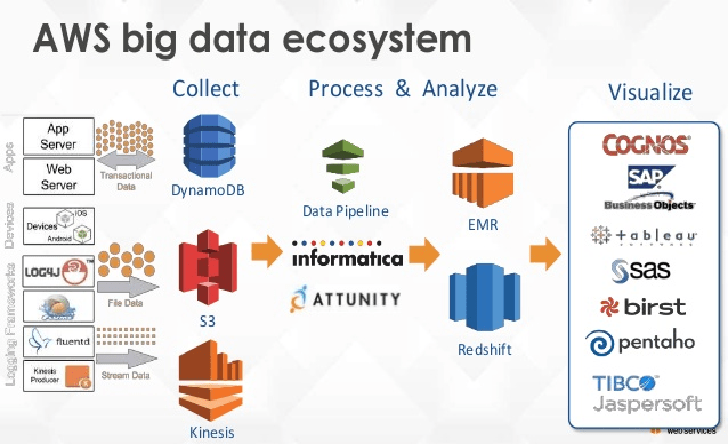
A general overview of the well-designed framework. AWS cloud architecture also distinguished five distinct features into five separate categories.
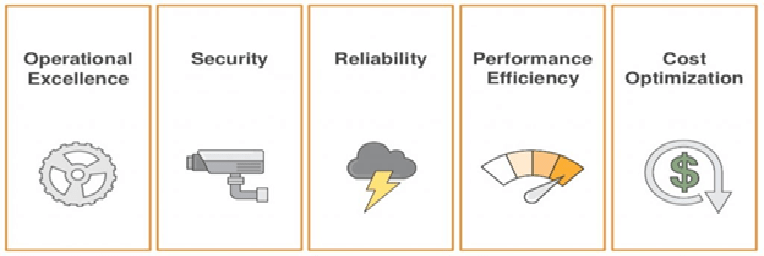
Operational excellence is the capacity to run and track programs that are doing what they’re supposed to be doing and that continues to grow. AWS discusses best practices in six standards of design:
- Perform operations as code
- Document the work.
- Make many, infrequent, reversible adjustments.
Maintain procedures regularly, identify and improve weaknesses in procedures.
Security and risk management deal with protecting records, processes, and properties while also providing market value. In securing the infrastructure, Amazon offers six concepts that can help:
- Develop a solid identification base
- Secure authentication at all levels.
- Enhance software compliance.
- Defend data in transit and at rest
- Prevent individuals from gaining access to data and prevent data from being broken into.
Reliability is making sure the device is capable of responding to problems causing networks or service delays, delivering processing power, mitigating disruptions and network issues. To improve stability, AWS recommends:
- Test recovery procedures
- Automatically recover from failure
- Scale horizontally to increase aggregate device availability
- Stop guessing capacity
- Manage shift in automation
Resource efficiency is the use of energy to achieve needs at the most efficient rate. In order to reach optimal productivity, there are five basic best practices.
- Democratize emerging technology by moving challenging technologies into the cloud vendor’s realm
- Go global in minutes
- Use server less architectures to help you easily deploy the system in different regions and remove the need to traditionally operate and manage servers
Use of technology in mechanical growth.
Service providers should be able to provide value at the lowest cost. To achieve the lowest total cost:
- Consume a blueprint.
- Measure total performance by analyzing the benefits generated by increasing productivity in order to reduce expenses.
- Decrease expenses on data center activities
- Identify cost drivers
- Utilize operated facilities to reduce the overall ownership expenses.
What are Amazon EC2’s benefits?
- It’s easy and quick to get started with EC2. The only thing you have to do is pick the Amazon Machine Images program (AMIs) from the AWS Marketplace and launch with Amazon EC2 immediately. To update the app, use the EC2 Amazon web services console or start with a single click.
- The Amazon EC2 is managed by Web Service Programming Interfaces as your software will scale automatically (APIs). Amazon EC2, which renders it a rendered AWS operation, enables you to commission any number of server instances simultaneously to maximize or reduce bandwidth in a couple of minutes.
- Customers get the monetary benefits of the Amazon scale. You just pay for the computing power at a very low cost. Though EC2 cloud architecture can be tried free, you can also select paying instances. In any case, everything that you have decided will be paid without a sudden or concealed charge.
- You can communicate with instances because you have root access for each of them so that you associate with every system. You, therefore, access completely the instances of your Amazon Web Services.
- Your IT services are protected and Amazon EC2 works with Amazon Virtual Private Cloud to strengthen the networking capabilities (Amazon VPC).
- You can build a vpc and enter instances if you don’t have the default VPC to exploit VPN links, private subnetworks, network ACLs, and output securities, amongst other advanced networking features.
- Amazon EC2 cloud architecture will provide storage, query, and computer solutions for a range of applications through its collaborations with Amazon Simple Queue Service, Amazon Simple Storage Service, Amazon SimpleDB, and Amazon Database Service.
2. Azure Cloud Architecture
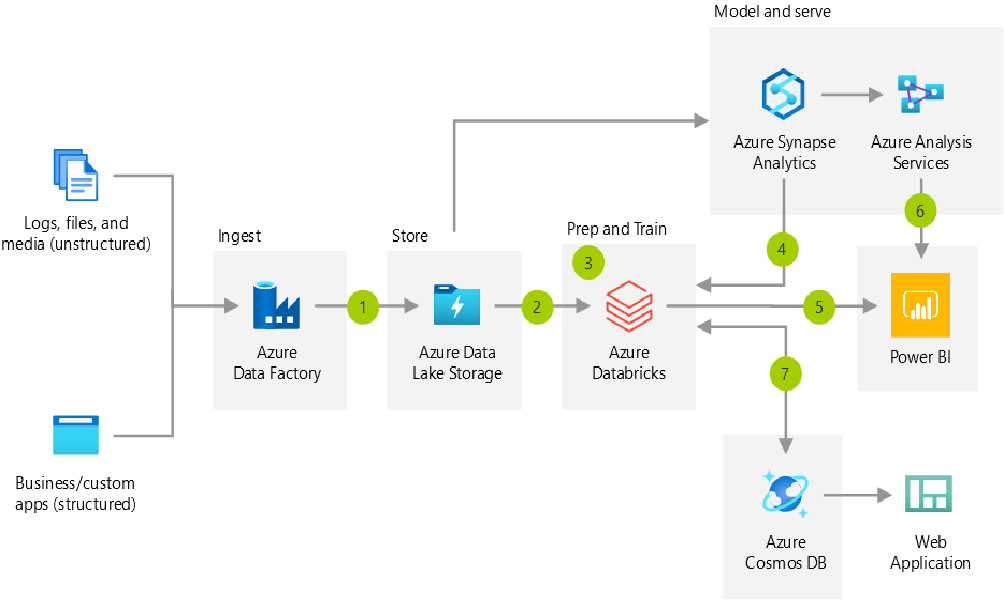
Microsoft Azure (formerly Windows Azure) cloud architecture is a Microsoft cloud infrastructure technology that allows software and services to be built, tested, deployed, and managed. Microsoft lists hundreds of Azure services that encompass: computers, telephone, storage, data administration, CDN, IoT, etc.
Features
- Microsoft Azure cloud architecture provides versatility, advanced site recuperation, and integrated integration. Azure’s cloud-based character makes it innately portable so that the data can be saved almost in any programming language, operating environment, or venue. You can also set backup timetables regularly, weekly, monthly, or anytime you like.
- Azure cloud architecture is an optimal medium on which web and smartphone applications can be created, hosted, and managed, making them independent and adaptable through features such as automated patch management, automotive scale, and on-site software integration.
- Microsoft Azure will merge your current access and identity function with your Active Directory. It also enhances the stability, global scope, and central management of your DNS.
- One of the aspects that makes Azure special is the freedom to expand the global scope of your Active Directory ecosystem while keeping full access. No other cloud provider will extend the scope and consolidate the management of your domain controller.
- The way organizations work and how software and technologies are designed changed in the cloud computing environment. Azure’s primary task is to ensure that the software provides market benefit by fulfilling the practical specifications of the company. However, it also involves ensuring the scalability, reliability, safety, and efficiency of the solution.
- Data is the most valuable and potentially harmful part of the IT technology of your company. Each architect must concentrate on securing access to the architecture by rigorous authentication and protecting your app and data from threats to the network. In order to secure your files, you can also use encryption protocols.
- Finally, please ensure that the architecture of your cloud is designed to make app creation and operation cost-effective. This would entail finding possible inefficiencies and excess zones, meaning you spend your IT money everywhere you can optimize ROI.
What are Azure Cloud Architecture’s benefits?
- IaaS is beneficial for the company to quickly and easily create, deploy and maintain applications. An enterprise can start or build a web app by customizing the cloud software and managing the facilities.
- Azure cloud architecture provides a considerable degree of versatility and gives you the choice to perform as needed. As you ingest, you can change to Azure, accommodate the changes in the market, etc. So, the infrastructure is not really worried.
- In terms of service, distribution, and scalability, Azure is rapid. This offers businesses a strategic edge in adopting Azure. The networks and software will be agile for the latest up-to-date cloud technologies.
- The stored data comply with the legislation that is particularly useful for the legal or financial sectors. It is based solely on the requirements for protection and privacy that every company will take the initiative.
- Azure has several data centers and distribution sites. It is well established. This allows quick distribution of information, optimum user experiences, storage of any data, and the secure and rapid sharing of data between virtual machines as needed.
- The spy film atmosphere protects the Azure info. Data centers provide two-tier authentication, proxy card entry scanners, biometric hand geometry readers, and a global response team to incidents. This reduces hacks to a larger degree.
- Azure provides built-in data analysis and insights into the management of SQL services, machine learning, streaming, and Cortana analysis. Your strategic choices are also taken more intelligently, leading to new markets.
- Azure is a solution from bottom to bottom. Both resources are available under a single umbrella for source management, unit checking, execution, live tools, or integrative testing. This does not trigger fear of integration and continuity problems.
- Customer trust is still secured by staying online. The capabilities of Azure to recover from disasters including regional/global failover options; rolling reboots and hot/cold standby modes provide the foundation for disaster response.
- Microsoft has an Azure stack offering that accepts the hybrid platform solution of customers. It allows the company to easily pick its data storage and transfer.
3. Google Cloud Architecture
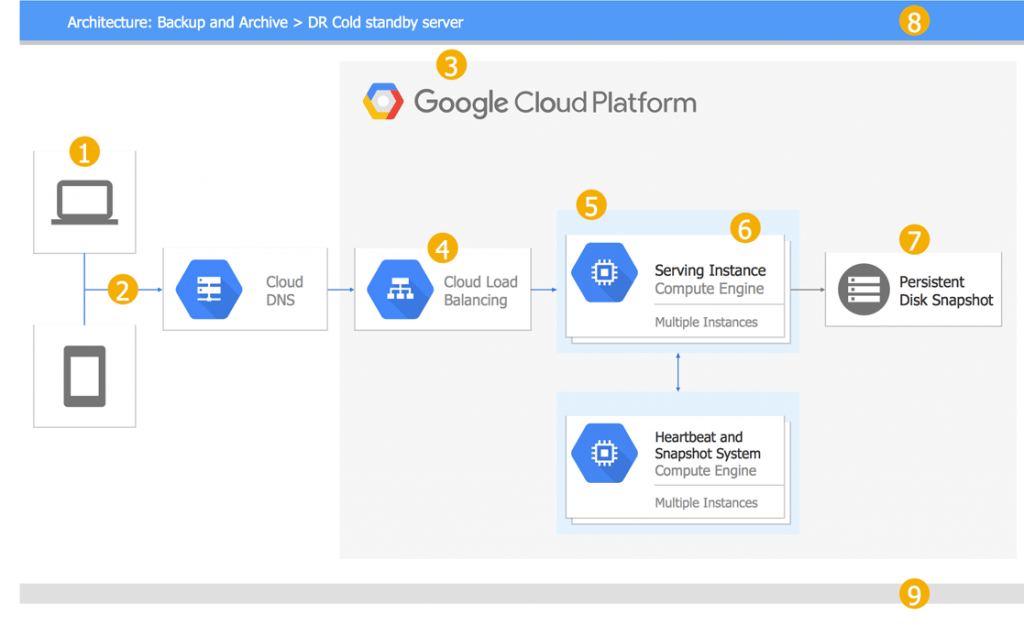
Google Cloud Network is an infrastructure mechanism and software providing customers with top-level cloud computing. Any of the GCP resources and support are available here: Calculation, computation, networking, big data, the transmission of data, IoT, and so on.
Features
Assets on the Google cloud architecture are rugged. One way of navigating around these systems is to see what options can be found on the basis of your key computer needs: service infrastructure (IaaS), service platform (PaaS), and service applications (SaaS).
- IaaS allows IT to operate virtual computers without investing in or managing this information technology itself. Sometimes when working time, experimental or unforeseeable adjustments take place, IT chooses an IaaS solution (e.g., sandbox projects).
- Next move is the PaaS, which builds on IaaS. Customers vote for all of IaaS’ advantages plus underlying technology such as middleware and operating systems. Both these components are hosted and managed by the provider.
- SaaS goes a step further – everything is accessible through the Web: the vendor hosts, maintains, and provides all the infrastructure, apps included. Users simply log into software such as backup and recovery tools for accessing particular solutions.
The service-offering category is another way of navigating the Google cloud platform. The main types of service include:
- Tools for managing
- Safety and identity
- large-scale data
- Machine Learning / Artificial Data (AI) (ML)
- Database storage and
- Connections
- Calculate.
What are Google Cloud Architecture’s benefits?
- Higher productivity due to rapid access to innovation: Google’s platforms will offer weekly and efficient alerts.
- Less Disruption as new functionality is adopted by users: Google provides scalable upgrades in continuous streams, rather than major disruptive batches of changes.
- Employees from around the globe can work from anywhere: Google cloud-enabled Web-based applications give you unlimited access to information on every smartphone worldwide.
- Google Cloud Allows rapid collaboration: Many people can participate, view, and store data on cloud projects instead of their computers simultaneously.
- Google’s Protection Protect Clients Investment: Clients profit from Google’s process-based and physical security investments. Hires top security professionals from Google.
- Less Vulnerable Devices data stored: On phones, which may become infected if a person ceases using cloud Web-based applications, minimum data is processed.
- Uptime and reliability are increased to our customers: if there is no data center operational for whatever purpose, the device will automatically revert to the secondary center without any user delay of operation.
- Flexibility and control User-friendly: They have technology power and are data owners of Google applications. You can get information from Google Cloud if you want to no longer use the Service.
- Google’s Scale Services Let Customers Pay Less: Google reduces overhead and reinforces a few server settings. It manages these through an effective computer-to-people ratio.
4. IBM Cloud Architecture

The IBM cloud architecture is an IBM suite of cloud computing applications that provides both a service interface (PaaS) and a service architecture (IaaS). IBM Cloud IaaS allows enterprises to deploy virtualized IT services (such as processing, storage, and networking) over the Internet and to access them.
It is a suite of cloud computing applications offered by IBM, including both a PaaS interface and a service infrastructure (IaaS). IT tools, such as the capacity of computing, storing, and networking, can be deployed and accessed over the Internet by companies with IBM Cloud IaaS. Organizations can choose between a bare metal or virtual servers for computing.
Items and utilities from IBM Cloud
IBM Cloud provides access to IBM’s other tools and services—including serverless IBM Watson, IBM Cloud functionality—and third-party providers.
The IBM Cloud Catalog lists more than 170 category providers, among them:
Calculate — Include diverse computer services, including bare-metal servers, serverless servers, and containers where companies can host workloads Calculate:
- Network — provides cloud networking facilities, such as load balancer, CDN, virtual network tunnels (VPN), and firewalls;
- Database – Provides cloud data storage with objects, blocks, and files;
- Manage – Provides tools such as log processing, automation, and core infrastructure (IaC) for managing and monitoring cloud deployments;
- Security—Includes activity tracking, identification and access management, and authentication services; — provides the SQL, NoSQL, and migration tools;
- Analytics — provides data science tools such as Apache Spark, Apache Hadoop, and IBM Watson Machine Learning, as well as data streaming analytics services;
What are the benefits of IBM Cloud Architecture’s ?
- In order to accommodate fluctuating workloads, scalability cloud computing scales upon demand.
- Storage alternatives- Upon security requirements and other considerations, users may select public, proprietary, hybrid, or other storage offers.
- With as-a-service solutions, Control Choices–Organizations will define their level of control.
- Includes software as a service (SaaS), service platform (PaaS), and service infrastructure (IaaS).
- Users may choose a solution that meets their particular requirements from the menu of pre-built software and functions.
- Security features – Private virtual cloud, confidentiality, and API keys help maintain data security. Applications and data based on Open Cloud are available on nearly any computer connecting to the Internet.
- Speed to market in the cloud allows consumers to easily market their apps. Because of networked backups, computer security failure in the hardware does not lead to data loss.
- Equipment savings-Cloud storage uses remote infrastructure, saving server and other equipment costs to organizations.
- Pay Structure-A pay structure for ‘utility’ implies that consumers pay only for their use of services. Simplified CSPs control the technology behind them, allowing providers to concentrate on application growth and other goals.
- Regular service providers refresh their services on a regular basis to provide customers the latest technologies. Work with international connectivity ensures that teams from around the globe will work together. The competitive edge organizations can do better to manage their infrastructure than rivals who would dedicate their IT capital.
5. Alibaba Cloud Architecture
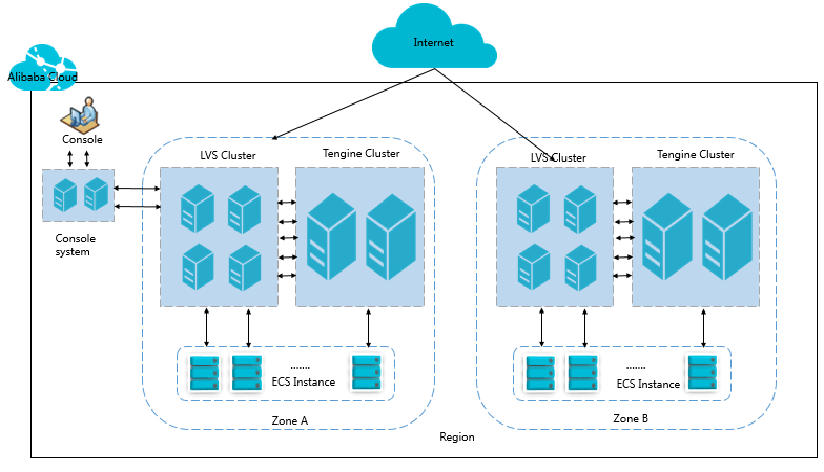
The Alibaba cloud architecture, as the Alibaba Group’s cloud computing unit, offers a wide variety of cloud platforms offering state-of-the-art computer technology, database, networking, security, and storage services.
Features
- Alibaba cloud architecture provides a comprehensive set of cloud products and services to the database, network, security, web and analytics, domain and application, media, middleware, and more. and other services. We provide an overview of Alibaba Cloud’s core computing, storage, and management offerings in this segment.
- Alibaba Cloud’s Elastic Compute Service is available from 17 foreign regions with various zones of accessibility — all run from a one-in-one global account — with state-of-the-art hardware (memory, CPUs) and built-in anti-DDoS security.
- Alibaba Cloud’s simple ECS service is operated on Windows and Server operating systems, including Auto Scaling and Load Balancing Service, all paid for running only, such as for instance ECS instances, real load balancer, and network traffic.
AC also offers scalable compute facilities with high efficiency, including:
- Elastic GPU Services (EGS): the high-demand computer system of Alibaba Cloud is designed for deep-learning, graphics, and video reproduction.
- E-HPC: all layers HP support: IaaS HP CPU, PaaS device programming stack for HP, SaaS customization of program templates.
- ECS Bare Metal (EBM): EBM instances merge the elasticity of a virtual server with the performance and function of a fitness server based on AC’s own virtualization technologies.
- SuperComputing Cluster (SCC): Superior network capacity and the acceleration ratio of massive clusters are based on EBM instances and high-speed RDMA networking (RDMA).
- Alibaba Cloud’s Container Infrastructure is a directly managed service for stable operation and management for Docker apps in a distributed cluster of ECS instance applications, with containers now being popular in-app architecture. Container Clusters can be created by Alibaba Cloud users, all of them entirely complementary to the Docker Standard APIs. The AC also has image hosting, imagery creation facilities, and image authorization feature stable and handy container registry.
What are Alibaba Cloud Architecture’s Benefits?
- The Alibaba Group knows both the vulnerability and the significance of cyber protection with its vast web-based security experiences and hundreds of well-known e-commerce platforms in China such as Taobao, Tmall, and Alpay. The Alibaba Cloud Anti-DDoS Basic cloud protection service interfaces with Alibaba Cloud ECS, protecting data and DDoS attack applications. The visibility and monitoring of the security controls will be improved for users.
- Alibaba cloud architecture is the first cloud protection service to receive ISO27001 certification in China. Furthermore, the Cloud Security Alliance (CSA) Star is the first cloud service provider to provide certification for Cloud Security Alliance (CSA Star certification is an enhanced ISO/IEC standard for cloud security issues).
- Alibaba Cloud is the world’s largest cloud platform and one of the world’s leading providers of cloud services. In Chinese IaaS markets, Alibaba’s cloud division holds 22%, while Amazon Web Service holds a 28% market share in the global IaaS market.
Alibaba Cloud now provides borderless cloud services that have a minimum latency of 14 data centers and an international network. Via a single global account, users could access their services worldwide. - Alibaba Cloud is well known for its high scalability and hybrid capacity with scalable computing resources, integrated real-time data analysis, and analytical capabilities in the world’s biggest hybrid cloud architecture. Apsara, Alibaba Cloud’s supercomputing engine, is capable of ensuring network and systems performance.
6. Huawei Cloud Architecture
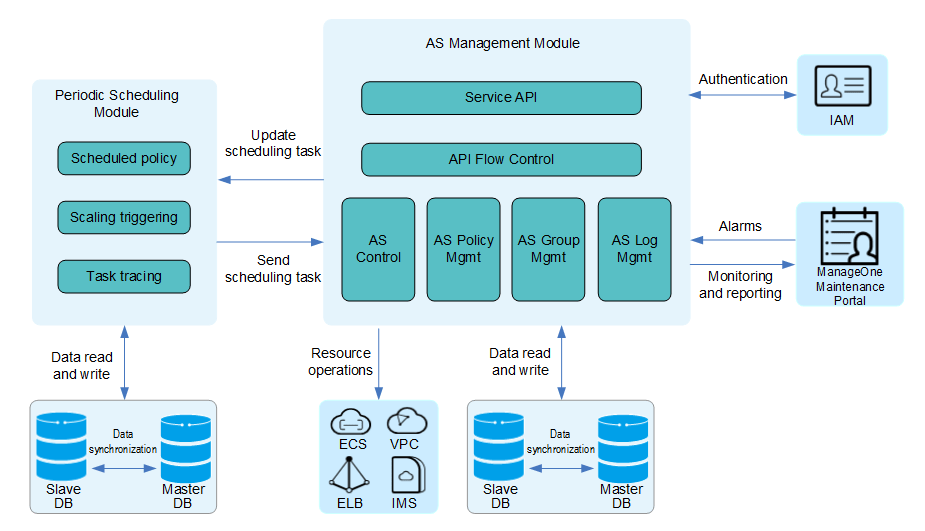
Huawei Cloud, the Huawei marquee cloud infrastructure brand. The brand aims to provide stable, safe, efficient, and sustainable cloud services to support smart organizations of all sizes.
Features
- With the 30+ years of know-how in ICT infrastructure products and technologies, HUAWEI cloud architecture, Huawei Brande’s cloud services brand, consumers can integrate with a comprehensive facility what they need into their profiles.
- The brand commits itself to deliver stable, secure, efficient, and sustainable cloud platforms that support smart companies of all sizes.
The HUAWEI CLOUD Inclusive IP Approach complements the already imposing products, encourages everyone to get what they need at a reasonable price point, makes the most advanced technology convenient to use, and ensures they have a completely safe profile over the lifecycle.
- HUAWEI CLOUD introduced a total of 180 cloud offerings and a total of 180 more solutions by the end of June 2019. HUAWEI CLOUD is a company that has been able to profit substantially from news outlets, social media sites, law enforcement, carmakers, gene sequencing companies, financial services, and a long list of clients across the industry.
In addition, 3500 apps from more than 6000 partners have been introduced to the HUAWEI CLOUD market. HUAWEI CLOUD has developed a single O&M tool framework that increases O&M productivity.
Worldwide recognized certifications have been granted in connection with O&M and security monitoring processing, such as PCI-DSS, ISO20000, ISO 27001 and ISO 27018, and SOC, Trusted Cloud Service (TRUCS). - HUAWEI CLOUD is No. 1 in cloud infrastructure efficiency and stability in China, according to various third-party tests.
- HUAWEI CLOUD is a solid, easy-to-use computing platform to support Huawei’s all-inclusive AI strategy. HUAWEI CONNECT 2018 saw the introduction of its one-stop ModelArts AI development platform and its Quantum Computing Simulator and HiQ Program Interface, AI vision technology development platform HILENS.
In order to promote cooperation with developers, collaborators, universities, and academic organizations, Huawei is also developing its AI Developer Enabling Program with the ultimate aim to make AI more inclusive.
What are Huawei Cloud Architecture’s Benefits?
- User data on PCs may be inadvertently disclosed or destroyed due to network attacks in conventional desktop environments. Terminals are separated from the data that is stored and analyzed in a data center in desktop environments.
- Furthermore, various security steps are taken to ensure the security and safety of the desktop device, such as TC authentication and encrypted data transfer.
- There is a high failure rate for a standard desktop machine. The figures show that the devoted engineer needs a total of 400 PCs to be managed and maintained, and the PC repair process takes 2 to 4 hours.
- Both software and utilities are processed on PCs in conventional desktop environments. The reliability of the system is 99.5% with a 21-hour annual downtime.
Both software and facilities are handled in a data center with 99.9 percent stability and good performance in the FusionAccess desktop solution. Better reliability continues to lower costs for management and servicing. - Users only require a dedicated computer to control desktops in standard computing environments. Users can access their desktops anywhere with the FusionAccess desktop solution, as long as they have a connection to the network.
Due to the processing of data and desktops in the data center, users can switch from place to place without interrupting programs at work.
- The application of TCs decreases noise from 50 dB to 10 dB in workplaces. The TC and Liquid Crystal Display (LCD) consumption is approximately 60 W. In comparison with conventional PCs, this reduces power costs by 70%. Reduced energy consumption often reduces the expense of control temperature.
7. Oracle Cloud Architecture
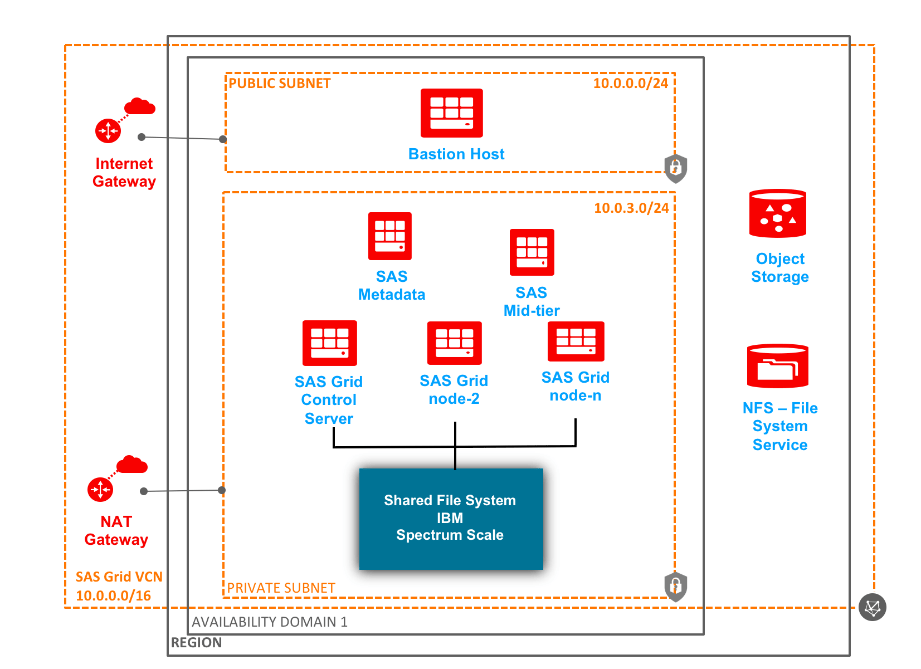
Oracle cloud architecture refers to Oracle’s server, database, network, apps, and services provided by a suite of cloud services, through the global network of data centers run by Oracle Corporation. The Corporation permits the supply of these services on-demand over the Internet.
Key characteristics
- Learn Oracle NoSQL Database Cloud Service’s core features. Fully managed using Zero Administration. No data servers or the underlying technology and protection are required for developers. Oracle retains hardware and software that enables developers to concentrate on developing apps.
- Fast Development Life cycle: Developers code their software and connect to the service using their passwords after they have purchased access to the service. Data can be read and written right away. This enables developers to focus on providing high-performance software through data databases management, storage management, high availability, and scalability.
- Oracle NoSQL Database Cloud Service is using the new component technology in the Oracle Cloud Infrastructure to provide high-scale performance. Developers realize that, even as their performance and storage requirements improve, their applications return data with predictable latencies.
- Producing and storing on request Supply: Oracle NoSQL Database Cloud Service scales with low and consistent latency server consistency criteria. When workloads escalate with seasonal market fluctuations, apps may increase their supply to ensure that their user interface remains stable.
With reduced workload, the same applications will minimize their delivery and lower running costs. The same applies to storage needs. The Oracle Cloud Infrastructure Console or Table Request API allows you to raise or decrease capacity.
- Simple APIs: Oracle’s NoSQL Database Cloud Service offers easy-to-use CRUDs, allowing users to conveniently generate tables and manage data in them.
- Data Modeling: Database Cloud Service Oracle NoSQL allows schema-based as well as schema-less (JSON) modeling.
- Data security in redundancy: Data storage in different availability domain(s) or defective domain(s) in single AD regions is carried out by Oracle NoSQL Database Cloud Service. If an AD or an FD is not available then use data from another AD or FD is still usable.
Transition to Oracle Cloud Architecture potential benefits
Oracle Cloud Applications offers market possibilities that obsolete legacy platforms can’t deliver – in addition to keeping up with the new technological innovations:
- Reduction in costs: Oracle Cloud applications can significantly reduce costs, particularly in hardware, maintenance, and IT.
- Agility: Oracle Cloud applications enable companies to rapidly and efficiently meet evolving industrial circumstances, new technology, and consumer requirements.
- Valuableness: companies need not be concerned with the expansion of infrastructure with Oracle Cloud applications.
- Higher security: Oracle Cloud Applications are configured for Oracle’s self-repair systems on an autonomous database to provide optimal security and minimized risk.
- Error reduction: companies can significantly eliminate errors with Oracle digital business processes and centralized data access.
8. Tencent Cloud Architecture

Tencent’s cloud architecture is the world’s largest cloud infrastructure offered by Tencent. Tencent Cloud offers cloud-based services that address a broad range of IT development needs, including computing, data storage, and more.
Features
- Tencent cloud architecture is a leading contributor to social networks, mobile payments, streaming content, eSports, music, and others. Leverage Tencent’s comprehensive ecosystem of core goods across different verticals as well as its extensive experience and networks to achieve a strategic advantage and influence these markets on your own.
- With the support of seven safety labs and a comprehensive smart security management system, Tencent Cloud prioritizes cloud security testing, operation, and platform protection to help you create a secure cloudification security mechanism.
- Tencent Cloud has vast expertise in the field. Tencent Cloud provides quick, cost-effective solutions for common business scenarios across numerous industries. It encompasses a wide variety of solutions that take you from China’s portal, entertainment, e-commerce, etc. to the cloud.
What are Tencent Cloud Architecture’s Benefits?
- If required, you can call a large number of CVM services to be used free of charge via BatchCompute and just pay for the individual CVM instances.
- Furthermore, you don’t have to worry about infrastructure construction and maintenance, cost savings, and time.
- BatchCompute can be completely used on request, and only if you have a workflow can you use it to get the requisite tools.
- It can handle and plan resources entirely, which is the most difficult aspect of batch computation, only defining and submitting computing jobs and then concentrating on results processing and solving the problems.
- Also it features a range of supplementary functions, including the definition of different deployment approaches, orchestration of computer processes, and tracking of the operating status, which allow you to identify and apply computer tasks.
- It may also operate in conjunction with other related Tencent Cloud providers, such as COS. It offers a one-stop shut-off facility for the acquisition, submission, and execution of computation materials and upload of computation results.
Conclusion
In short, modern technical developments in cloud architecture were recently developed and will have a major influence on the environment. It offers consumers and enterprises multiple advantages. One advantage for companies, for example, is that it reduces operational costs by investing less in repairs and software improvement and concentrates more on the companies themselves.
But the cloud infrastructure needs to address other hurdles. People are very cynical about the security and privacy of their records. Worldwide data from cloud architecture was not supplied by standards or legislation. Europe has legislation on data security. Users are also concerned with who will communicate their information and who owns their information. Yet cloud computing will once revolutionize the future globally, with rules and regulations.
About Writer
AB Rob
Founder & CEO
